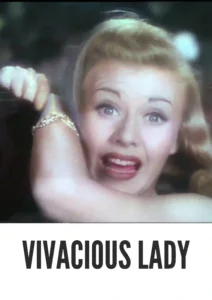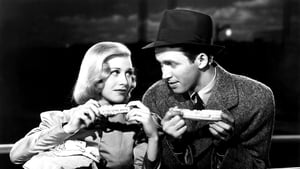Video Sources 0 Views
- Watch trailer
- Vivacious Lady 1938 Colorized


Synopsis
Table of Contents
ToggleFrom Nightclub Singer to Society Darling: Vivacious Lady (1938) in Vivid Color

Step back in time with Vivacious Lady, a delightful screwball comedy romance from 1938, now beautifully colorized for a fresh and vibrant viewing experience. Starring the charismatic Ginger Rogers and the ever-charming James Stewart, this film, also known as Love in a Big Way, is a testament to the golden age of Hollywood. Perfect for fans of classic cinema and those looking for a heartwarming, laugh-out-loud film, this HD download brings a timeless tale of love and acceptance to your screen.
Vivacious Lady Storyline: A Whirlwind Romance
Vivacious Lady tells the story of Peter Morgan Jr. (James Stewart), a young, somewhat reserved botany professor. While on a trip to New York City, Peter meets Francey (Ginger Rogers), a vivacious nightclub singer. The two quickly fall in love and impulsively get married.Returning to his conservative family and academic environment, Peter faces the challenge of introducing his free-spirited bride to his disapproving father, Peter Morgan Sr. (Charles Coburn), who is also the president of the college where Peter teaches. Francey’s unconventional ways clash with the stuffy atmosphere of the college town, leading to humorous misunderstandings and heartwarming moments as she tries to win over her new family and community. The film explores themes of tradition versus modernity, acceptance, and the transformative power of love, all wrapped in a lighthearted and entertaining package.
Movie Cast
The film boasts a stellar cast of actors who bring this comedic romance to life:
- Ginger Rogers as Francey
- James Stewart as Peter Morgan Jr.
- Charles Coburn as Peter Morgan Sr.
- Beulah Bondi as Helen, Peter’s Aunt
- Frances Mercer as Keith, Peter’s Fiancée
Movie Genre
Vivacious Lady expertly blends screwball comedy with romance, offering a delightful and heartwarming cinematic experience. Its witty dialogue, charming characters, and lighthearted plot make it a standout film in the genre.
Historical Context: Hollywood’s Golden Age
Released in 1938, Vivacious Lady is a shining example of Hollywood’s Golden Age, a period known for its glamorous stars, witty comedies, and heartwarming romances. The film reflects the era’s fascination with stories that balanced escapism with social commentary, offering audiences a chance to laugh while also pondering themes of love, family, and societal expectations.
Colorization Details
This colorized version of Vivacious Lady has been meticulously restored using modern digital techniques, enhancing the visual appeal while preserving the film’s original charm. The colorization process involved carefully analyzing the grayscale tones of the original black and white footage and assigning appropriate colors to each scene. This painstaking process breathes new life into the characters and settings, making the story even more engaging for modern audiences.
Technical Details
- Director: George Stevens
- Screenplay: P.J. Wolfson, Ernest Pagano
- Story: I.A.R. Wylie
- Cinematography: Bert Glennon
- Edited by: Henry Berman
- Production Company: RKO Radio Pictures
- Distributed by: RKO Radio Pictures
- Runtime: 90 minutes
Technical Specifications
- Download Format: MP4
- Resolution: HD (1080p)
- Compatibility: Compatible with most devices, including smartphones, tablets, computers, and smart TVs.
Reviews and Critical Reception
Vivacious Lady (1938) has been praised for its charming performances, witty dialogue, and heartwarming story. It remains a beloved classic of the screwball comedy genre, appreciated for its lighthearted humor and timeless themes.
FAQs
- Q: What is Vivacious Lady about?
- A: Vivacious Lady is a screwball comedy romance about a young professor who marries a nightclub singer and brings her back to his conservative family and college town.
- Q: Is Vivacious Lady (1938) a well-known classic film?
- A: Yes, Vivacious Lady is a beloved classic of Hollywood’s Golden Age, known for its charming performances and witty humor.
- Q: Is this version of Vivacious Lady colorized?
- A: Yes, this version has been professionally colorized to enhance the viewing experience.
- Q: What makes Vivacious Lady a must-watch for classic film fans?
- A: Vivacious Lady offers a delightful blend of screwball comedy and romance, showcasing the talents of Ginger Rogers and James Stewart in a heartwarming story about love and acceptance.
- Q: What is the download format?
- A: The download format is MP4, which is compatible with most devices.
- Q: What resolution is the download?
- A: The resolution is HD (1080p), providing a high-quality viewing experience.
Download Now in HD!
Watch Vivacious Lady Today!











